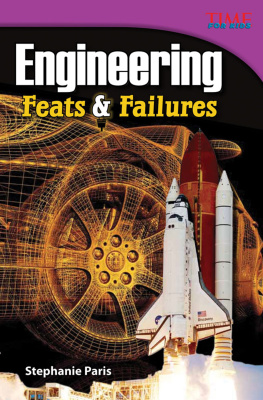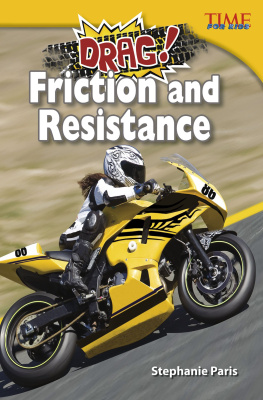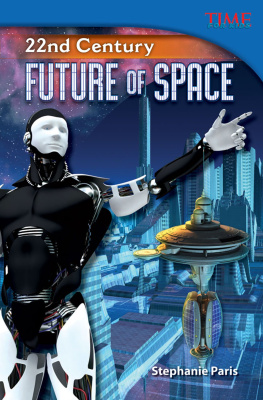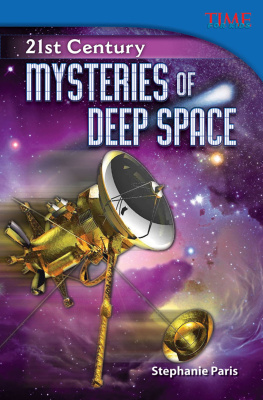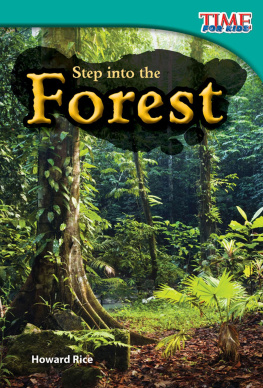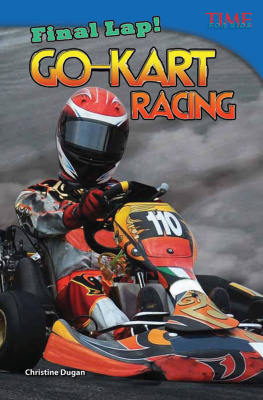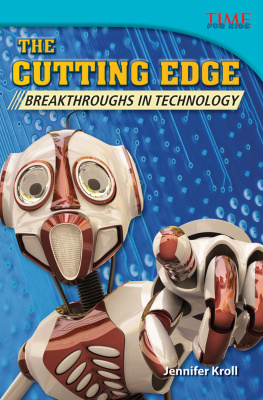
Stephanie Paris
Engineering
Engineering
Feats Failures
&


Teacher Created Materials
5301 Oceanus Drive
Huntington Beach, CA 92649-1030
http://www.tcmpub.com
ISBN 978-1-4333-4871-6
2013 Teacher Created Materials, Inc.
Consultants
Timothy Rasinski, Ph.D.
Kent State University
Lori Oczkus
Literacy Consultant
John Ferguson, AIA
Architect
Based on writing from
TIME For Kids. TIME For Kids and the TIME
For Kids logo are registered trademarks of
TIME Inc. Used under license.
Publishing Credits
Dona Herweck Rice , Editor-in-Chief
Lee Aucoin , Creative Director
Jamey Acosta , Senior Editor
Lexa Hoang , Designer
Stephanie Reid , Photo Editor
Rane Anderson , Contributing Author
Rachelle Cracchiolo , M.S.Ed., Publisher
Image Credits:
cover, pp.1, 3233, 38
(bottom), 41 (left & right) NASA; pp.9 (top) 26
(bottom) Alamy; p.27 (bottom) Associated
Press; p.40 (left) Bridgeman Art; p.2627
Bettmann/Corbis; pp.11 (top), 15 (top), 19
(bottom) Getty Images; p.12 (background)
duncan1890/iStockphoto; pp.1213, 2425, 35
Janelle Bell-Martin; p.40 (right) Emory Kristof/
National Geographic Stock; pp.1819, 20
(bottom) akg-images/Newscom; pp.29 (top
right), 34 (bottom) EPA/Newscom; pp.2021,
41 (top) picture-alliance/Judaica-Samml/
Newscom; p.29 (bottom left) REUTERS/
Newscom; p.1415 North Wind Picture
Archives; All other images from Shutterstock.
Synched Read-Along Version by:
Triangle Interactive LLC
PO Box 573
Prior Lake, MN 55372
ISBN-13: 978-1-68444-928-6 (e-book)

Table
Contents
Making It Work ................
Early Engineers ................
The Industrial Age .............
Engineering Today .............
Glossary .....................
Index .......................
Bibliography .................
More to Explore ...............
About the Author ..............
of

Making It
Work
Scientists learn things. But engineers do
things. Engineers use science and math to make
things. Sometimes, they solve a big problem.
They may find a way to build a bridge across a
river. Other times, they make life easier. It was
an engineer who figured out how to make water
flow from a sink.
For thousands of years, engineers have
made huge buildings. They have created great
machines. Again and again, they find brilliant
ways to solve problems. But engineers are
people. And people make mistakes. Sometimes,
the most amazing feats turn into terrible failures.

How is new technology developed?
Why are failures and mistakes big
parts of success?
How have advances in science,
technology, and engineering
improved our lives?

Early
Engineers
The Great Pyramid
of Giza
Ancient engineers made huge structures with
basic tools. They used ramps, levers, and simple
rollers. These tools helped them build monuments
that still impress people today. People are still
trying to figure out how these ancient engineers
did their work!
Because they were built so long ago, few ancient
feats can still be seen today. But there are some.
The Great Pyramid is the only Ancient Wonder of
the World that still exists. It was built as a tomb for
Pharaoh Khufu. It is nearly feet high. Each
side measures feet long. It is made from over
two million blocks of stone. Each block weighs over
two tons! Scientists think workers built large wooden
ramps. Then, they dragged each block into place.
There are seven official Ancient Wonders of the
World, including gardens, monuments, temples,
and a great lighthouse. All the ancient wonders
were built between 2650
BC
and
BC.

Pyramid Workers
If the Great Pyramid has 2,300,000 stones
and each stone weighs 2.5 tons, how heavy is
the Great Pyramid?
2.5 tons x 2,300,000 stones = ?
Monument Math
Egyptian records show that many of
the pyramid workers were forced to
work. But they were treated well by the
standards of the time. There were rules
about how many hours they could work
each day. They had fair wages, and there
were even official holidays.

The Great Wall
Ancient Chinese rulers had a problem. They
needed a better way to stop invaders. So they built
a wall nearly feet tall and 2,000 miles long. The
wall wasnt built overnight. It took close to 1,800
years to complete.
The wall was made in segments. The segments
were connected over many years. Together, they
form the giant wall that exists today. Passes
allowed people to travel from one side of the wall
to the other. Soldiers watched for danger from
signal towers.
Engineers used rivers, lakes, and mountains
to extend the wall. With these natural
dividers, the wall protects over 5,500 miles.

The Great Failure
Even though the Great Wall is the longest wall
in the world, eventually it failed to keep out
invaders. Genghis Khan (GANG-gus KAHN) , a
Mongol ruler, and his army were a threat to
China. In part, the wall was built to stop them,

